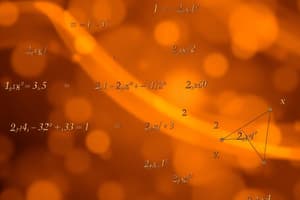Podcast
Questions and Answers
What is the formula used by the Affine cipher for encryption?
What is the formula used by the Affine cipher for encryption?
- $c = jm + k$
- $c = m + k \mod n$
- $c = jm + k \mod n$ (correct)
- $c = m \cdot j + k \mod n$
How many possible key values does the Affine cipher have?
How many possible key values does the Affine cipher have?
- 12
- 312 (correct)
- 26
- 104
What should the approximate key length of the Vigenère cipher be for the English language, in bits?
What should the approximate key length of the Vigenère cipher be for the English language, in bits?
- 15
- 16 (correct)
- 30
- 8
What is a necessary step in breaking the normal Vigenère cipher?
What is a necessary step in breaking the normal Vigenère cipher?
What does measuring redundancy in a language involve, specifically in written texts?
What does measuring redundancy in a language involve, specifically in written texts?
How many words are estimated to exist in the English language, relevant for the Vigenère cipher's key length?
How many words are estimated to exist in the English language, relevant for the Vigenère cipher's key length?
Why is the quality of explanations considered in grading?
Why is the quality of explanations considered in grading?
What is the purpose of having a general-purpose dictionary during the exam?
What is the purpose of having a general-purpose dictionary during the exam?
What is the average entropy measured for long sequences of English text?
What is the average entropy measured for long sequences of English text?
How does a stream cipher avoid the main drawback of one time padding?
How does a stream cipher avoid the main drawback of one time padding?
How is perfect secrecy mathematically defined for a cryptosystem?
How is perfect secrecy mathematically defined for a cryptosystem?
Why are real-world pseudo-random number generators (PRNGs) periodic?
Why are real-world pseudo-random number generators (PRNGs) periodic?
What is the size |K| of the set of all possible keys k ∈ K for a generic block cipher?
What is the size |K| of the set of all possible keys k ∈ K for a generic block cipher?
What is the computational challenge of solving xe = c mod n compared to factoring n = pq?
What is the computational challenge of solving xe = c mod n compared to factoring n = pq?
Which parameter is NOT typically chosen when setting up RSA?
Which parameter is NOT typically chosen when setting up RSA?
What is a significant reason that makes generic block ciphers impractical?
What is a significant reason that makes generic block ciphers impractical?
What is the value of φ(n) when n = pq where p and q are large primes?
What is the value of φ(n) when n = pq where p and q are large primes?
Why is the knapsack problem considered insecure despite being NP-complete?
Why is the knapsack problem considered insecure despite being NP-complete?
What distinguishes a Message Authentication Code (MAC) from a digital signature?
What distinguishes a Message Authentication Code (MAC) from a digital signature?
What best describes a blind signature?
What best describes a blind signature?
How does Bob obtain a document signature from Alice using the RSA blind signature process?
How does Bob obtain a document signature from Alice using the RSA blind signature process?
What is the primary difference between bit commitment and zero-knowledge schemes?
What is the primary difference between bit commitment and zero-knowledge schemes?
What role does random challenge play in zero-knowledge proof systems?
What role does random challenge play in zero-knowledge proof systems?
Why are digital signatures not considered to be zero-knowledge?
Why are digital signatures not considered to be zero-knowledge?
Flashcards
Affine cipher
Affine cipher
A cipher that uses a key consisting of two integers (j and k) to encrypt a message. It encrypts each letter in a message by multiplying it by the first key (j) and adding the second key (k) modulo 26.
Vigenere cipher key length
Vigenere cipher key length
The key length of a Vigenere cipher should be the length of a common English word. This range is typically considered to be between 30,000 and 100,000 words, representing approximately 15-16 bits of information.
Breaking Vigenere Cipher
Breaking Vigenere Cipher
Breaking Vigenere involves finding the key length and then identifying the individual Caesar shifts used for each letter position. This is done by analyzing repeating patterns in the ciphertext and calculating the greatest common divisor (GCD) of their distances. Once the key length is found, you can identify the individual Caesar shifts by looking at the letter frequencies in each block corresponding to each letter of the key.
Language redundancy
Language redundancy
Signup and view all the flashcards
ASCII representation
ASCII representation
Signup and view all the flashcards
Stream cipher
Stream cipher
Signup and view all the flashcards
Random number generation (RNG)
Random number generation (RNG)
Signup and view all the flashcards
Nonce
Nonce
Signup and view all the flashcards
Entropy of English Text
Entropy of English Text
Signup and view all the flashcards
Stream Cipher vs. One-Time Pad
Stream Cipher vs. One-Time Pad
Signup and view all the flashcards
Perfect Secrecy
Perfect Secrecy
Signup and view all the flashcards
Periodicity of PRNGs
Periodicity of PRNGs
Signup and view all the flashcards
Complexity of Generic Block Ciphers
Complexity of Generic Block Ciphers
Signup and view all the flashcards
RSA Complexity: Encryption vs. Factoring
RSA Complexity: Encryption vs. Factoring
Signup and view all the flashcards
RSA Parameters: p, q, n, e, d
RSA Parameters: p, q, n, e, d
Signup and view all the flashcards
Diffie-Hellman Key Exchange
Diffie-Hellman Key Exchange
Signup and view all the flashcards
One-time pad
One-time pad
Signup and view all the flashcards
Symmetric-key cryptography
Symmetric-key cryptography
Signup and view all the flashcards
Asymmetric-key cryptography
Asymmetric-key cryptography
Signup and view all the flashcards
Blind signature
Blind signature
Signup and view all the flashcards
Zero-knowledge proof
Zero-knowledge proof
Signup and view all the flashcards
Secret sharing
Secret sharing
Signup and view all the flashcards
Pseudo-random number generation
Pseudo-random number generation
Signup and view all the flashcards
Zero-knowledge proof of ownership
Zero-knowledge proof of ownership
Signup and view all the flashcards
Study Notes
Cryptology Exam - October 25, 2024
-
Permitted Equipment: General-purpose dictionaries for English translations (no personal notes, formulas, or external help)
-
Solutions: Posted on Lisam after the exam
-
Grading: Minimum points for grades 3, 4, and 5 are 13, 19, and 27, respectively, out of a total of 39 points. Numeric grades are converted to ECTS grades.
-
Examiner Visit: Examiner will answer questions in exam rooms around 3 PM.
-
Other Information: Answers can be in English. Explanation quality affects grading. Keep answers concise.
Question 1: Principles and History
-
(a) Affine Cipher: An encryption method using a modular arithmetic formula (c = jm + k (mod n)). Has 312 possible key values.
-
(b) Vigenère Cipher Key Length: Should be the length of an English word (approximately 15-16 bits, depending on source data).
-
(c) Breaking Vigenère: The method involves finding the keyword length using greatest common divisor (GCD) of distances between repeated characters. This then reveals the Caesar cipher used for each letter, determined via single-character statistics for each substitution to deduce the key.
Question 2: Foundations and Basic Theory, Stream Ciphers, RNGs
-
(a) Language Redundancy: Measured as average entropy per letter in long sequences (approximately 1 bit/letter).
-
(b) Stream Cipher Drawback: OTP (one time pad) drawbacks are avoided in stream ciphers by expanding a short secret key using a public key expansion process (reducing secure-channel transmission length).
-
(c) Perfect Secrecy: Defined mathematically as H(M|C) = H(M) where M is plaintext and C is ciphertext.
Question 3: Block Ciphers
- (a) Block Cipher Key Size: (2n)! is the extremely large number of permutations, which is impractical for generic block ciphers.
Question 4: Public Key Principles, One-Way Functions, RSA & Knapsack, Diffie-Hellman, ElGamal
-
(a) Computational Hardness Comparison: Factoring n = pq and computing xe = c (mod n) are equally hard problems, proven using the Chinese Remainder Theorem.
-
(b) RSA Parameters: Chosen as prime numbers p and q (n= pq), $φ(n) = (p-1)(q-1)$, prime e such that gcd(e, φ(n)) = 1 and d such that ed≡ 1 (mod $φ(n)$).
-
(c) Knapsack Problem: The knapsack problem is NP-complete but becomes significantly easier if a superincreasing one maps to superincreasing knapsack.
Question 5: Message Authentication and Digital Signatures
-
(a) MAC vs. Digital Signature: Message Authentication Code (MAC) uses symmetric cryptography, while digital signatures use asymmetric cryptography.
-
(b) Blind Signature: A signature created for a message with unknown content, shielding the message's content from the signature creator.
Question 6: Bit Commitment, Zero Knowledge, Secret Sharing, Games over the Phone
- (a) Bit Commitment vs. Zero Knowledge: Bit commitment uses one-way functions; zero-knowledge schemes use random commitment and random challenges.
- (b) Coin Tossing/Poker: Bit commitment ensures a fair game.
- (c) Digital Signatures and Zero Knowledge: Digital signatures lack random challenges and commitment features, thus not a zero-knowledge scheme.
Question 7: Post-Quantum Cryptography
-
(a) Post-Quantum Cryptography: Cryptosystems based on lattice problems to avoid quantum computer attacks are called post-quantum.RSA is not post-quantum because factoring is vulnerable to quantum algorithms
-
(b) SIS Acronym: Short Integer Solution.
-
(c) SIS Hash Function Definition (missing): Not Provided.
Question 8 (Page 5): LWE and McEliece
- (a) Security Sources: Both depend on decoding general linear codes. McEliece relies heavily on the code family selection; LWE on the other hand, employs randomness in the code selection.
Studying That Suits You
Use AI to generate personalized quizzes and flashcards to suit your learning preferences.




